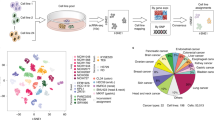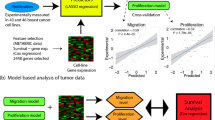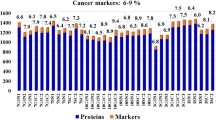Abstract
The varied nature of human cancers is recapitulated, at least to some extent, in the diverse NCI-60 panel of human cancer cell lines. Here, I used a basic, continuous variable of proliferating cells, their doubling time, to stratify the proteome across the NCI-60 cell lines. Among >7000 proteins quantified in the NCI-60 panel previously, the levels of 84 proteins increase in cells that proliferate slowly. This set overlapped with the hallmark molecular signature “epithelial-mesenchymal transition (EMT)” (p value = 1.1E−07). Conversely, the levels of 105 proteins increased in cells that proliferate faster and overlapped with the molecular signatures for “MYC targets V1” (p value = 3.8E−38) and “E2F targets” (p value = 2.4E−34). These data for the first time identify proteins whose levels are dynamically associated with doubling time, but not necessarily with cancer type origins, and argue for the incorporation of doubling time measurements in cell line-based profiling studies.
Similar content being viewed by others
Text
Much of the molecular characterization of cancer cells tends to be categorical in nature, probably because there are many different types of cancer. Consequently, when biomolecules are measured in cancer cells, they are often reported in categorical terms. For example, countless studies report on proteins whose levels or activity may be high in one cancer but very low or absent in other types of cancer or normal cells. Such approaches are valuable, pointing to molecular signatures unique to specific cancers. However, they also miss molecular variables that are continuous in nature, not discreet. The molecular characterization of the NCI-60 cell lines is extensive. Proteomic variation is of special interest for two reasons: First, proteins represent the vast majority of targets of anticancer drugs. Second, differential protein expression underpins the behavior of the different cancers represented in the panel [1,2,3,4]. The overwhelming emphasis and underlying assumptions in such comparative profiling approaches are that strong cell line clustering of protein levels provides biomarkers that are specific to particular tumors. But the different cancer cell lines in the NCI-60 panel also display distinct cell proliferation rates, or doubling times (Td), ranging from 17 to 80 h [5, 6]. However, the different doubling times of the cell lines are rarely taken into consideration in comparative profiling analyses. The NCI-60 panel is the only system for which systematic measurements of the proteome and cell cycle times are available for such a wide range of human cells, cancerous or not. The extent to which differences in doubling times among the NCI-60 cancer cell lines are related to the observed differences in protein levels has not been explored.
Quantitative immunoblotting against a limited number of target proteins was originally used to query the proteome of the NCI-60 panel [2, 3], followed by comprehensive mass spectrometry approaches [1]. Accurate values for the doubling time of each cell line are available from NCI’s Developmental Therapeutics Program (DTP), representing the average of multiple independent estimates [5, 6]. To test for positive or negative association between the levels of each protein and the doubling time, I used Spearman’s non-parametric, distribution-free test for independence based on ranks. A correlation matrix of all the protein levels in each cell line against the doubling time of that cell line was generated, using the rcor function of the R language package Hmisc. This analysis yielded the Spearman rank correlation coefficient r and the corresponding p value for the association between the levels of each protein and the doubling time (Td), shown in Fig. 1. The levels of the vast majority of proteins, including proteins with housekeeping functions, did not correlate strongly with the doubling time (Td) of the cell populations. However, the levels of two groups of proteins were highly correlated with Td, either positively or negatively with (|r| > 0.41, p < 0.001; see Fig. 1). The above analysis alone does not offer a view of the magnitude of the correlation: protein levels may only change within a very narrow range. For those proteins whose levels were correlated to Td, the slope of the regression of protein levels on Td would yield the magnitude of the effect. Hence, linear regression models for each protein whose levels were highly correlated with Td were constructed (Fig. 1). For the regression analyses, the non-parametric, Siegel repeated median estimates [7] were used to obtain the slopes and intercepts of the linear models (with the R language package mblm).
Identifying proteins associated with the growth rate of cancer cells. The Spearman rank correlation coefficient r (y-axis) for the association between the levels of each protein and the doubling time (Td) in the NCI-60 panel. The red vertical lines indicate the p value cutoff (p < 0.001). From these Td-correlated proteins, we estimated the slope of the linear regression model and retained cases with a |slope| >0.1. The 84 proteins associated with long Td are shown in Additional file 1: Table S1, while the 105 proteins associated with short Td are shown in Additional file 1: Table S2. The gene ontology (GO) categories of biological processes associated with these proteins are shown in Additional file 1: Tables S3 and S4
Overall, from >7000 proteins that entered this analysis, from the significance cutoffs we applied (p < 0.001), one would have expected <8 proteins by chance to be correlated with long, or short, Td. However, we found that the levels of 84 were not only correlated with Td but also the slope of the regression of those protein levels on Td was greater than 0.1 (Fig. 1; Additional file 1: Table S1). The levels of those proteins increase in cells that have a higher Td and proliferate slowly. To gauge the physiological significance of these findings, the interactive and freely available Enrichr platform [8, 9] was used for enrichment analysis for biological processes and molecular pathways. The set of 84 proteins whose levels increase in cells that proliferate slower were enriched for the related biological processes “collagen fibril organization” and “extracellular matrix organization” (GO: 0030199 and GO: 0030198; see Additional file 1: Table S3). The same group of proteins also overlapped significantly with the hallmark (Molecular Signatures Database; MSigDB [10]) sets for “epithelial-mesenchymal transition (EMT)” (p value = 1.1E−07) and “protein secretion” (p value = 1.1E−06). The slowest proliferating cell lines may resemble differentiated cells more than other cell lines. However, it did not seem to be the case that a specific cancer type is enriched in the slower growing cell lines. For example, the six slowest proliferating cell lines were from non-small cell lung (LC: HOP-92), Renal (RE: A498 and RXF393), central nervous system (CNS: SNB-75) and breast (BR: BT-549) cancers. Some of the fastest proliferating cell lines were also from the same types of cancer (LC: NCI-H460 and A549, RE: 786-0, CNS: U251). Activation of the EMT program is known to play a key role in cancer cell invasion and metastasis [11, 12]. These data suggest that that induction of the EMT program is associated with lower rates of cell proliferation, which may be a property of metastasizing cells. While it is not known whether the slower growing NCI60 cell lines are more prone to undergo EMT in orthotopic models, it is known that overexpression of certain proteins is sufficient to cause EMT, slow tumor growth, and late steps in metastasis [13].
Conversely, the levels of 105 proteins regressed on Td with a slope lower than −0.1. The levels of those proteins increase in cancer cells that proliferate fast and have a lower Td (Fig. 1; Additional file 1: Table S2). The set of 105 proteins whose levels increase in cells that proliferate faster were enriched for the biological processes “positive regulation of telomerase RNA localization to Cajal body” and “DNA strand elongation involved in DNA replication” (GO: 19048746 and GO: 0006271; see Additional file 1: Table S4). The same set of 105 proteins also overlapped to a very significant extent with the hallmark sets for “MYC targets V1” (p value = 3.8E−38) and “E2F targets” (p value = 2.4E−34). Therefore, many proteins in this set control cell growth and the timing of initiation of cell division at the G1/S transition. In this set of 105 proteins, five are already classified as oncogenic in MSigDB (DDX5, DDX6, ATIC, HSP90AB1, CBFB). The overwhelming majority of the proteins in this set are involved in cell division and cell growth. Cell growth (increase in mass) determines the rate at which cells proliferate [14], but how cells couple their growth with their division is not well understood. These data underscore the fundamental and cooperative role of the MYC and E2F networks in the physiological coupling between growth and division, to control rates of cell proliferation [15].
In conclusion, the above analysis argues that it is reasonable to incorporate the doubling time as a key phenotypic variable when profiling the behavior of different cancer cell lines. Specifically, protein biomarkers that emerge from the profiling of these cell lines may be a reflection of the doubling time of the particular cell line, and not necessarily attributed to the origin of the cancer type in question. Lastly, a surprising result of this study is that the levels of ‘housekeeping’ gene products (e.g., ribosomal proteins) are not dynamically associated with growth rate. Instead, it was the levels of other functional groups of proteins (e.g., the MYC and E2F networks) that appear to be more closely associated with rates of cell proliferation.
References
Gholami AM, Hahne H, Wu Z, Auer FJ, Meng C, Wilhelm M, Kuster B. Global proteome analysis of the NCI-60 cell line panel. Cell Rep. 2013;4(3):609–20.
Nishizuka S, Charboneau L, Young L, Major S, Reinhold WC, Waltham M, Kouros-Mehr H, Bussey KJ, Lee JK, Espina V, et al. Proteomic profiling of the NCI-60 cancer cell lines using new high-density reverse-phase lysate microarrays. Proc Natl Acad Sci USA. 2003;100(24):14229–34.
Shankavaram UT, Reinhold WC, Nishizuka S, Major S, Morita D, Chary KK, Reimers MA, Scherf U, Kahn A, Dolginow D, et al. Transcript and protein expression profiles of the NCI-60 cancer cell panel: an integromic microarray study. Mol Cancer Ther. 2007;6(3):820–32.
Park ES, Rabinovsky R, Carey M, Hennessy BT, Agarwal R, Liu W, Ju Z, Deng W, Lu Y, Woo HG, et al. Integrative analysis of proteomic signatures, mutations, and drug responsiveness in the NCI 60 cancer cell line set. Mol Cancer Ther. 2010;9(2):257–67.
Scherf U, Ross DT, Waltham M, Smith LH, Lee JK, Tanabe L, Kohn KW, Reinhold WC, Myers TG, Andrews DT, et al. A gene expression database for the molecular pharmacology of cancer. Nat Genet. 2000;24(3):236–44.
Ross DT, Scherf U, Eisen MB, Perou CM, Rees C, Spellman P, Iyer V, Jeffrey SS, Van de Rijn M, Waltham M, et al. Systematic variation in gene expression patterns in human cancer cell lines. Nat Genet. 2000;24(3):227–35.
Siegel AF. Robust regression using repeated medians. Biometrika. 1982;69(1):242–4.
Kuleshov MV, Jones MR, Rouillard AD, Fernandez NF, Duan Q, Wang Z, Koplev S, Jenkins SL, Jagodnik KM, Lachmann A, et al. Enrichr: a comprehensive gene set enrichment analysis web server 2016 update. Nucleic Acids Res. 2016;44(W1):W90–7.
Chen EY, Tan CM, Kou Y, Duan Q, Wang Z, Meirelles GV, Clark NR, Ma’ayan A. Enrichr: interactive and collaborative HTML5 gene list enrichment analysis tool. BMC Bioinform. 2013;14:128.
Liberzon A, Birger C, Thorvaldsdottir H, Ghandi M, Mesirov JP, Tamayo P. The molecular signatures database (MSigDB) hallmark gene set collection. Cell Syst. 2015;1(6):417–25.
Ombrato L, Malanchi I. The EMT universe: space between cancer cell dissemination and metastasis initiation. Crit Rev Oncog. 2014;19(5):349–61.
Tsai JH, Yang J. Epithelial-mesenchymal plasticity in carcinoma metastasis. Genes Dev. 2013;27(20):2192–206.
Waerner T, Alacakaptan M, Tamir I, Oberauer R, Gal A, Brabletz T, Schreiber M, Jechlinger M, Beug H. ILEI: a cytokine essential for EMT, tumor formation, and late events in metastasis in epithelial cells. Cancer Cell. 2006;10(3):227–39.
Polymenis M, Aramayo R. Translate to divide: control of the cell cycle by protein synthesis. Microb Cell. 2015;2(4):94–104.
Miles WO, Dyson NJ. RB-loss puts focus on Myc. Nat Cell Biol. 2015;17(8):968–9.
Acknowledgements
Not applicable.
Competing interests
The author declares that he has no competing interests.
Availability of data and materials
All data generated or analysed during this study are included in this published article and its Additional file 1.
Consent for publication
Not applicable.
Ethics approval and consent to participate
Not applicable.
Funding
Work in the author’s laboratory is supported by the National Institutes of Health (1R01GM123139).
Publisher’s Note
Springer Nature remains neutral with regard to jurisdictional claims in published maps and institutional affiliations.
Author information
Authors and Affiliations
Corresponding author
Additional file
Rights and permissions
Open Access This article is distributed under the terms of the Creative Commons Attribution 4.0 International License (http://creativecommons.org/licenses/by/4.0/), which permits unrestricted use, distribution, and reproduction in any medium, provided you give appropriate credit to the original author(s) and the source, provide a link to the Creative Commons license, and indicate if changes were made. The Creative Commons Public Domain Dedication waiver (http://creativecommons.org/publicdomain/zero/1.0/) applies to the data made available in this article, unless otherwise stated.





